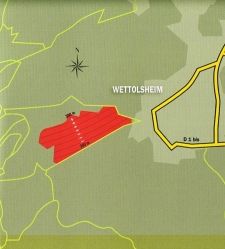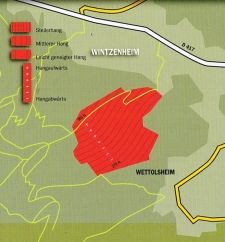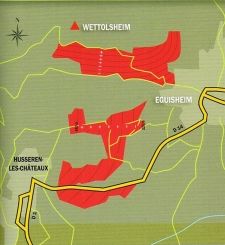The Grands Crus
We propose 3 Grand Crus Wines which are the “Steingrubler”, the “Hengst”, and the “Pfersigberg” in three different grape varieties: Riesling, Pinot Gris and Gewurztraminer.
They represent the single combination of the soil and grape variety, as well as the importance of three factors: the ground, the exposure and the microclimate. They are wines of a great aromatic smoothness, rich and powerful, expressing the character of their origin. Wines of long guard produced in limited quantity.
The Grand Cru Steingrubler

To the west of Wettolsheim, the Steingrubler is situated on a southeast facing hillside between 280 and 350 meters of altitude. Its clay sandy soils cover a marl soil and calcareous conglomerate from the Oligocene era, partially covered with scree and granite.
The more sandy upper part of the Steingrubler is ideally suited to Riesling. The richer, more limestone lower part is perfect for Gewurztraminer and Pinot Gris.
The Grands Crus Steingrubler wines are rich in aroma, full-bodied and solidly-structured, offering a bouquet of great finesse with floral or mineral nuances. These wines age very well.
The Grand Cru Hengst

On the southern fringes of Wintzenheim, the vineyard faces southeast, at an altitude of 270 to 360 meters, extended across a large wind-sheltered slope.
The soil is mainly composed of Tertiary border conglomerates with interstratified calcareous marl, ideal for vine growing in Alsace.
The 75,78ha of Hengst is dominated by Gewurztraminer, but both Pinot Gris and Riesling occupy a privileged position.
In its youth, the wine is quite in accordance with its name, it has an untamed character (Hengst means stallion). Bottle-ageing softens, refines and tames it. It will astonish gourmets and connoisseurs by its ageing potential (10 to 20 years or more).
The Grand Cru Pfersigberg

Situated on the towns of Wettolsheim and Eguisheim, the Pfersigberg slopes face east-south-east and are particularly well-exposed to the sun. They are protected from oceanic influence by an impressive massif of mountains. The stony conglomerate subsoil of the hillside is formed of various limestone pebbles. In this type of clay-silt textured soil, water retention is average, and so, the soil colour and low humidity favorite the radiance of intense heat, which leads to early ripening of the grapes.
The 74,55ha of Pfersigberg is ideally suited to Gewurztraminer. The Pinot Gris, Riesling and Muscat d’Alsace also develop great richness, elegance and finesse.
Pfersigberg wines, especially Gewurztraminer, are noted for their body, fruitiness, aroma and ageing potential.